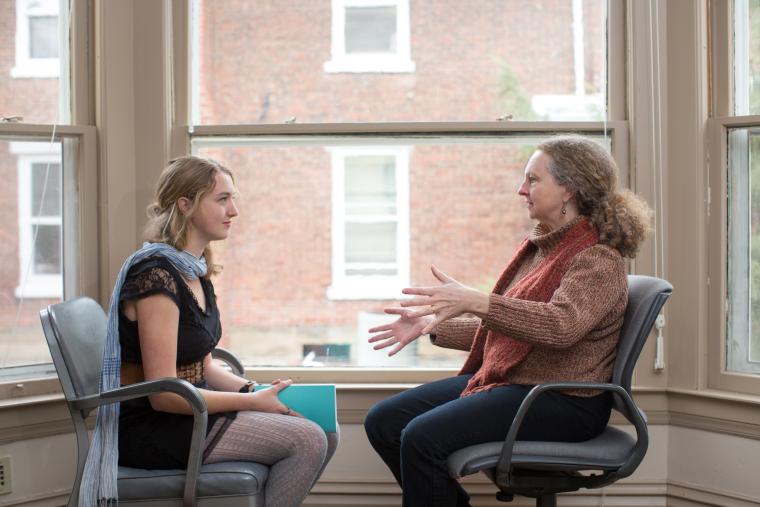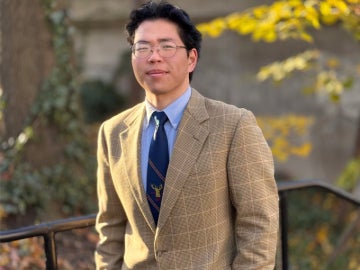Finding Their Voices
December 9, 2013
Amanda Nagy

Sarah Cheshire, a senior majoring in creative writing and gender, sexuality and feminist studies, talks with Visiting Assistant Professor Lynn Powell.
Photo credit: Tanya Rosen-Jones
Samsun Knight came to Oberlin fully confident that he would be a writer. He had already begun to hone his craft in his Boston-area high school, which offered strong writing programs. So when he wasn’t accepted into Oberlin’s highly sought-after Creative Writing Program, the rejection left him humbled and disappointed—but even more determined.
“When I was a freshman, I thought I was way ahead of the game,” says Knight, now a senior. “I was really arrogant. When I didn’t get into the Creative Writing Program, it threw me for a loop.”
In retrospect, Knight says he is grateful that he wasn’t accepted right away. Following a year of self-discovery through courses, readings, and a winter term abroad, he was admitted to the program his sophomore year. “I came back with a new attitude and feeling out of my league. I thought the other creative writing students were much better writers than I was. Now, I believe that for a lot of creative processes, you have to be able to switch between supreme overconfidence and utter self-loathing.”
Knight’s creative formula is working in his favor: His series of short stories will be published in the prominent West Coast literary journal Glimmer Train in November 2014. Stories published in Glimmer Train—which has been discovering (and paying) emerging writers since 1990—are represented in recent editions of the Pushcart Prize: Best of the Small Presses, New Stories from the Midwest, The PEN/O. Henry Prize Stories, New Stories from the South, Best of the West, and Best American Short Stories. According to the journal’s website, in a recent Best American Short Stories, six Glimmer Train pieces are listed as “notables”—second only to the New Yorker. Two of the six were those authors’ first-ever publications.
Writing, however, isn’t Knight’s only passion. He is a triple major: In addition to creative writing, he is pursuing degrees in economics and mathematics. He has also completed Oberlin’s advanced Chinese language courses. (He’s currently enrolled in a private reading of Journey to the West.)
Oberlin is one of the few undergraduate institutions with a self-standing creative writing major, and most students in the program are double majors, says Sylvia Watanabe, associate professor and co-director of the program. The majority of creative writing programs at the undergraduate level are housed within English departments, and yet most of those only offer minors or concentrations in creative writing.
Oberlin accepts 24 students into the Gateway 201 course—a prerequisite for upper-level workshops—and receives upward of 70 applicants for those spots each semester.
To be published as an undergraduate opens doors much earlier in a student’s academic and professional career. The Creative Writing Program’s emphasis on production and individual mentoring is helping undergrads find their voice early. In addition to writing and publishing, creative writing alumni have taken career paths as varied as medicine, education, law, journalism, electronic media, and social work.
“The skills that they acquire as creative writing majors—in using and analyzing language, in close observation, in critiquing texts, in writing narrative, and especially in developing empathy for a wide variety of human perspectives—are very portable skills that are useful in a variety of professions,” Watanabe says.
Getting published as an undergraduate allows emerging writers to get their name out and build confidence in their writing, says Laura Grothaus, a 2013 graduate who double majored in creative writing and visual arts. Pieces of the work that she did during her senior year were published in Scintilla, an online literary arts journal, and she won the Phyllis Jones Memorial Award and the Stuart Friebert Academy of American Poets Prize. Her work with drawing and writing was displayed in galleries in New York and Oberlin. Her poetry also has been published in So to Speak, a print journal. This past summer, she was runner-up in a national poetry competition hosted by the largest poetry conference in the United States.
“Oberlin's Creative Writing Program fostered my work in a way that few other institutions would, if for no other reason than that I was able to take writing classes every semester with professors who were dedicated to seeing how my work could grow,” Grothaus says. “I was constantly writing and occasionally learning about publications and contests that I don't think I would have found otherwise.
“I think, at its best, publication allows you to enter a conversation with a community of writers interested in the same discussions you are. Randomly submitting to literary journals isn't really my style, though it's perfectly acceptable if your goal is to simply get your work out there. My goal is to find new voices that I want to keep reading, and to submit to the places where they send work.”
Grothaus is currently working on projects she started her senior year, including a novella retelling the ghost stories her father told her, a long poem about physics and mythology, and a series of poems using images as footnotes.
In Sarah Cheshire’s White Noise, ghosts and forms of hauntings are metaphors for stories left untold. Cheshire, a senior in the creative writing program, will have her nonfiction piece published in a forthcoming anthology of Creative Nonfiction, entitled Southern Sin: True Stories of the Sultry South and Women Behaving Badly. Cheshire, who is a North Carolina native, wrote the piece for Lynn Powell’s 201 Gateway course.
Cheshire credits Visiting Assistant Professor Bernard Matambo for nurturing her personal development in his Poetry 110 course. “I can’t emphasize enough the caliber of teaching on an intellectual, creative, and personal level,” says Cheshire, a Bonner Scholar who is also majoring in gender, sexuality and feminist studies. “I feel respected — like my voice has an equal stake in conversations. I can really have faith in my stories.”
You may also like…
Learning by Teaching: Oberlin Students Share Global Music with Young Learners
College and Conservatory students in PACE 103 prepare local children for an immersive community concert at Oberlin.
Nuiko Wadden ’02 Joins Oberlin Conservatory Faculty as Assistant Professor of Harp
The versatile musician brings extensive opera, orchestral, and contemporary music experience to her role
Leo Hidy ’23 Earns 2026 Marshall Scholarship
Leo Hidy ’23, a comparative American studies major who also studied business and economics while at Oberlin, has received a 2026 Marshall Scholarship that will fund two years of graduate study in the UK.


